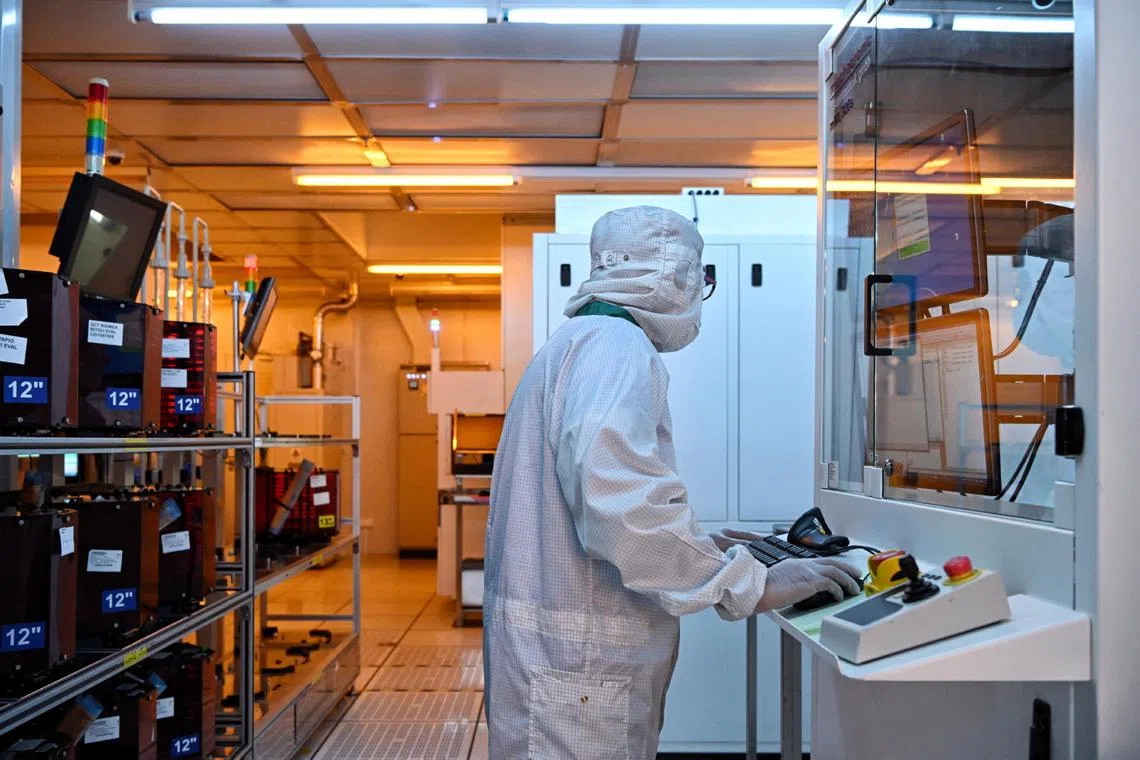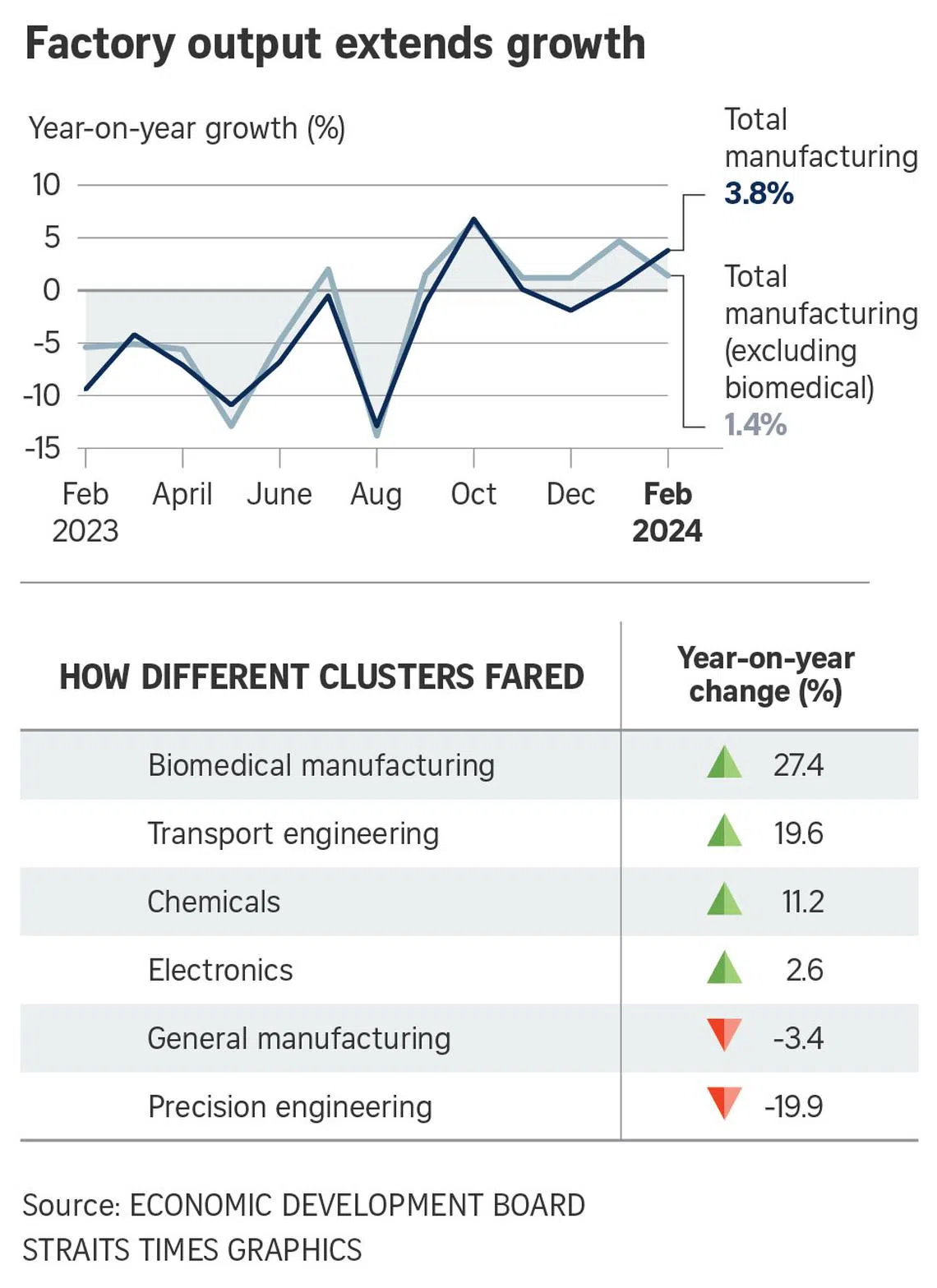Singapore factory output beats forecasts with 3.8% rise in February
Sign up now: Get ST's newsletters delivered to your inbox

Excluding the more volatile biomedical industry, output increased by 1.4 per cent in February.
PHOTO: ST FILE
Follow topic:
SINGAPORE - Singapore’s factory output extended its expansion in February, growing 3.8 per cent year on year and beating analysts’ expectations.
This topped the 0.5 per cent growth forecast made by economists in a Bloomberg poll.
Excluding the more volatile biomedical industry, output increased by 1.4 per cent in February.
However, January’s growth was revised lower to 0.6 per cent from an earlier estimate of 1.1 per cent, figures from the Economic Development Board (EDB) showed.
Bright spots in February included a slim 2.6 per cent increase in output by the key electronics industry, after it shrank 4.7 per cent in January.
Within the industry, the infocomms and consumer electronics segment grew 30.9 per cent, while semiconductors added 2.1 per cent, and other electronics modules and components increased by 0.3 per cent. However, the computer peripherals and data storage segment contracted 10.7 per cent.
The biomedical industry also returned to growth in February, with output expanding 27.4 per cent after shrinking 25.9 per cent in January.
The pharmaceutical segment grew 73.2 per cent, with the production of more biological products and a different mix of active pharmaceutical ingredients.
Conversely, the medical technology segment declined 3.9 per cent on the back of lower exports of medical devices, EDB said.
The chemicals sector was another bright spot in February, with output rising 11.2 per cent. The petrochemicals segment grew 22.3 per cent on the back of a low production base in 2023, partly due to plant maintenance shutdowns, EDB noted.
The specialities segment and petroleum segments also grew, with the former recording higher output of mineral oil additives. In contrast, the other chemicals segment declined 8.2 per cent due to lower output in fragrances.
Output also increased in transport engineering, with the sector recording a rise of 19.6 per cent. The aerospace segment expanded 37.3 per cent from a low production base a year ago due in part to component shortages, EDB said. However, the marine and offshore engineering segment declined 3.5 per cent, with a lower level of activity in the shipyards due to the Chinese New Year holiday.
Two industries, however, saw production decline.
Precision engineering output slumped as output fell 19.9 per cent. The precision modules and components segment contracted 15.1 per cent. The machinery and systems segment shrank 20.4 per cent, mainly due to lower production of semiconductor-related equipment.
General manufacturing’s output dropped 3.4 per cent. The printing and food, beverages and tobacco segments grew but the miscellaneous industries segment contracted, led by lower production of construction-related materials.

Maybank Research regional co-head of macro research Chua Hak Bin said manufacturing is staging a gradual but bumpy recovery.
He also observed that the outlook for semiconductors remains bullish, supported by an artificial intelligence boom, low American electronic inventories and a replacement tech cycle.
Global semiconductor sales rose 15.2 per cent year on year in January, the Semiconductor Industry Association reported earlier in March.
OCBC Bank chief economist Selena Ling noted that this is the second month of year-on-year growth.
“It is also encouraging that it’s a 14.2 per cent growth month on month, seasonally adjusted, despite Chinese New Year falling in February. The bright spots are the rebound in electronics, especially semiconductors, and biomedical clusters,” she said.
For the full year 2024, she said analysts are still looking for at least a 2 per cent improvement over 2023.
“Given the large weightage of electronics, especially semiconductors, whether the global demand outlook can sustain (growth) will be key,” Ms Ling said.
China’s recovery will also be important, coupled with the geopolitical outlook, she added.
National University of Singapore business professor Lawrence Loh said that the growth trend in manufacturing is not surprising as sectors like information and electronics, as well as the biomedical and pharmaceutical industries, are responding to global optimism.
“Global growth worldwide is well in progress... Manufacturing sentiments in these front-line sectors will lead the turnaround. We will expect other sectors to follow suit in due course,” he said.
Dr Chua is also pencilling Singapore’s first-quarter gross domestic product growth to come in at 2.5 per cent – the higher end of the official 1 per cent to 3 per cent forecast range.
“Stronger trade-related and hospitality services – because of the Taylor Swift boost – will also help drive first-quarter growth,” he said.


